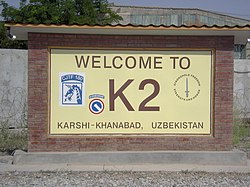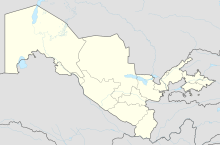This article needs additional citations for verification. (December 2012) |
Karshi-Khanabad (or K2) is an air base in southeastern Uzbekistan, just east of Karshi. It is home to the 60th Separate Mixed Aviation Brigade of the Uzbek Air Force.
Karshi-Khanabad Air Base | |||||||||||
|---|---|---|---|---|---|---|---|---|---|---|---|
 | |||||||||||
| Summary | |||||||||||
| Airport type | Military | ||||||||||
| Location | Karshi, Uzbekistan | ||||||||||
| Elevation AMSL | 1,365 ft / 416 m | ||||||||||
| Coordinates | 38°50′06″N 65°54′45″E / 38.83500°N 65.91250°E | ||||||||||
| Map | |||||||||||
 | |||||||||||
| Runways | |||||||||||
| |||||||||||
The airport is 1,365 feet (416 m) above mean sea level. It has one runway designated 07/25 with a concrete surface measuring 8,196 by 131 feet (2,498 m × 40 m).[1]
History
editFrom 1954 to 1981, the 735th Fighter Aviation Regiment of the 12th Independent Air Defense Army, Soviet Air Defence Force, was stationed at the base.[3] It was equipped with MiG-15 (July 1950 – 1955), MiG-17 (1955-1969), and then Sukhoi Su-9 (Fishpot) aircraft (1961-1978).[4] The regiment replaced the Su-9 in 1978 with the MiG-23M (Flogger-B).[4]
In 1981 it was renamed the 735th Fighter-Bomber Aviation Regiment, and in 1984 the 735th Bomber Aviation Regiment. Until 1984 the regiment was equipped with the MiG-23M, and from 1984 to 1992 with the Su-24. The regiment was under control of the Soviet Air Forces of the Turkestan Military District from April 1980 to May 1988, and then under 49th Air Army and 73rd Air Army.[citation needed]
On 30 June 1992, control of the base passed from the dissolved Soviet Union to Uzbekistan. From 1992 changes began to affect the regiment before it was merged with other units into the 60th Separate Mixed Aviation Brigade.
Following the 11 September 2001 attacks, U.S. Air Force Colonel Frank J. Kisner, Commander, 16th Operations Group, Hurlburt Field, FL, got to Karshi-Khanabad on 5 October 2001 just as advance elements of 5th Special Forces Group arrived.[5] There he was tasked to carry out combat search and rescue operations. The headquarters of the U.S. 10th Mountain Division arrived at the air base, under Major General Franklin L. Hagenbeck, on 12 December 2001 to function as the Combined Forces Land Component Command (CFLCC) (Forward).[6] The division headquarters served as the representative for Lieutenant General Paul T. Mikolashek, the CFLCC commanding general. It was responsible for controlling virtually all U.S. and allied ground forces in the theater, including the security of airfields in Afghanistan, Uzbekistan, and Pakistan, as well as the logistics operations set up to support those forces. The division was also intended to defend Uzbekistan against incursions by the Islamic Movement of Uzbekistan and other Islamist militant groups based in Afghanistan.[7] On 13 February 2002, Mikolashek ordered Hagenbeck to move CFLCC (Forward) to Bagram Airfield in Afghanistan and two days later the headquarters was redesignated as Combined Joint Task Force (CJTF) Mountain.[8]
Seven thousand United States Department of Defense personnel were located at the base, also known as K2 and "Camp Stronghold Freedom", between 2001 and 2005.[9] There they helped operate against the Taliban and al-Qaeda in neighboring Afghanistan during Operation Enduring Freedom. The 416th Air Expeditionary Group was the host unit. On 29 July 2005, amid strained relations caused by the May 2005 unrest in Uzbekistan; a prelude to another Color Revolution, the United States was told to vacate the base within six months. It was vacated by the United States in November 2005.[10][11]
Pollution
editIn November 2001, the United States Army Center for Health Promotion and Preventive Medicine-Europe performed an environmental baseline survey at the base. They found widespread jet fuel plumes, usually 1–3 meters under ground, most likely from a leaking Soviet-era underground fuel distribution system as well as smaller, localized areas of surface dirt contaminated with asbestos and low-level radioactive processed uranium. Both were attributed to the destruction of Soviet missiles several years prior.[12]
Former U.S. servicemembers described "black goo" oozing out of the soil, appearing to be a mixture of solvents, oils and other chemicals. Noxious vapors were also reported, along with radiation warning signs and a nearby pond that glowed green. Rainwater would reportedly flood tents and appeared contaminated with various chemicals.[13] According to a 2015 Army study, 61 of the K2 veterans had been diagnosed with cancer or died of the disease, not counting the special operations forces.[14] The United States Department of Veteran's Affairs and U.S. Army Public Health Center had denied that an increased rate of cancers exists or that any contamination at the base posed any serious health problems.[12] DOD took steps to reduce possible sources of contamination, such as filling trenches with soil to create a cap to hold vapors underground, and covering radioactive soil and asbestos,[12] which were criticized as ineffective by veterans.[14]
On 18 November 2020, the US House Committee on Oversight and Reform held a hearing on environmental health risks at the base.[15] A fact sheet was released detailing the health risks at the camp:[16]
- Petrochemical Contamination and Volatile Organic Compounds (VOCs)
- Particulate Matter 10 (PM10) and Tetrachloroethylene
- Burn pits
- Radiation exposure
As of the November 2020 hearing, the Department of Veterans' Affairs denied that the illnesses suffered by veterans at K2 suffered were service-connected.
See also
editReferences
edit- ^ a b "World Aero Data: KARSHI KHANABAD -- UTSL". worldaerodata.com. DAFIF. Archived from the original on 5 October 2017.
{{cite web}}: CS1 maint: unfit URL (link) - ^ Airport information for Karshi-Khanabad, Uzbekistan (UTSL / KSQ) at Great Circle Mapper. Source: DAFIF (effective October 2006).
- ^ Michael Holm. "735th Bomber Aviation Regiment". ww2.dk. Archived from the original on 11 February 2020. Retrieved 20 January 2021.
Karshi-Khanabad, Kashkadar'inskaya Oblast, 1954 - 1992 [38 50 09N, 65 55 19E]
- ^ a b "Phaseout of FISHPOT in APVO Stranny Airfields USSR" (PDF). cia.gov. Washington, D.C.: Central Intelligence Agency. February 1981. Archived from the original (PDF) on 23 January 2017. Retrieved 20 January 2021.
Document Type: CREST. Document Number (FOIA) /ESDN (CREST): CIA-RDP81T00380R000100980001-5
- ^ "Combined Joint Special Operations Task Force-Afghanistan, A Short History".
- ^ A Different Kind of War, 127.
- ^ Henriksen 2022.
- ^ A Different Kind of War, 132
- ^ Kime, Patricia (27 February 2020). "Post 9/11 veterans attribute deadly cancers to contaminants at US base in Uzbekistan". MilitaryTimes.com. Archived from the original on 30 November 2020. Retrieved 3 March 2020.
- ^ "US asked to leave Uzbek airbase". BBC News. 30 July 2005. Archived from the original on 8 November 2020.
- ^ "Last US plane leaves Uzbek base". BBC News. 21 November 2005. Archived from the original on 24 February 2020.
- ^ a b c U.S. Army Public Health Center 2020.
- ^ Browne, Ryan (9 July 2020). "Congress releases declassified Pentagon files showing deployed US troops were exposed to dangerous toxins". CNN. Archived from the original on 13 January 2021. Retrieved 10 July 2020.
- ^ a b Copp, Tara (19 December 2019). "Cancers strike veterans who deployed to Uzbek base where black goo oozed, ponds glowed". mcclatchydc.com. McClatchy.
- ^ Stephen F. Lynch, Chairman of the Subcommittee on National Security (18 November 2020). "Karshi-Khanabad: Honoring the Heroes of Camp Stronghold Freedom - House Committee on Oversight and Reform". oversight.house.gov. Archived from the original on 9 December 2020. Retrieved 20 January 2021.
"Today, many of [those who served at K2] face devastating health conditions potentially tied to their service. They are looking for answers—answers our government has denied them for years. Our Subcommittee's bipartisan investigation revealed clear evidence that K2 veterans were exposed to toxic and environmental hazards. Yet, the VA has refused to provide the full range of treatments and benefits these veterans deserve. I remain committed to advocating on behalf of our K2 heroes and look forward to hearing the VA and DOD's plans to right this injustice."
- ^ "Fact Sheet: Declassified Karshi-Khanabad (K2) Documents" (PDF). oversight.house.gov. 9 July 2020. Archived (PDF) from the original on 9 December 2020. Retrieved 20 January 2021.
During subsurface soil testing in 2001, "[e]levated levels of volatile organic compounds (VOCs) and total petroleum hydrocarbons (TPH) were detected at numerous locations throughout Stronghold Freedom. A June 2002 Operational Health Risk Assessment estimated that "between 50% and 75% of personnel at Stronghold Freedom will be exposed to elevated levels of compounds in air," and a September 2004 health assessment described the probability of exposure to PM10 levels as "frequent." A few air samples also reported elevated levels of tetrachloroethylene. According to the Agency for Toxic Substances & Disease Registry, "Studies in humans suggest that exposure to tetrachloroethylene might lead to a higher risk of getting bladder cancer, multiple myeloma, or non-Hodgkin's lymphoma." According to a September 2004 health assessment, the U.S. Army Center for Health Promotion and Preventive Medicine (USACHPPM) found that, although "less than 10% of personnel will experience [radiation] exposures above background" at Camp Stronghold Freedom, "the potential for daily contact with radiation exists for up to 100% of the assigned units."
- U.S. Army Public Health Center (2020). "Environmental Conditions at Karshi Khanabad (K-2) Air Base, Uzbekistan Information for Service Members and Veterans" (PDF). phc.amedd.army.mil. Archived (PDF) from the original on 19 January 2021. Retrieved 5 March 2020. This article incorporates text from this source, which is in the public domain.
- Henriksen, Thomas H. (31 January 2022). "Afghanistan". America's Wars: Interventions, Regime Change, and Insurgencies after the Cold War (1 ed.). Cambridge University Press. doi:10.1017/9781009053242.005. ISBN 978-1-009-05324-2.
